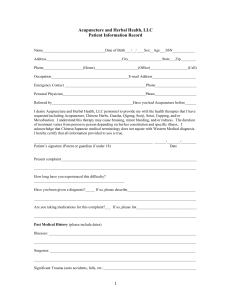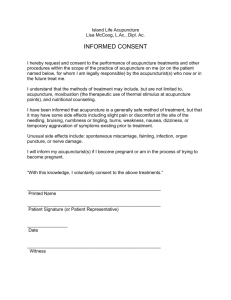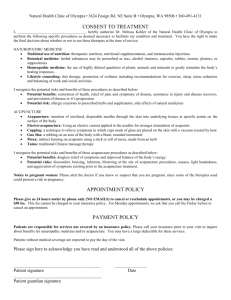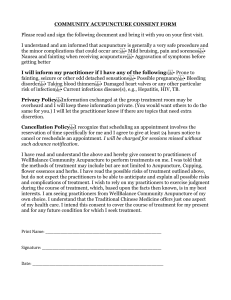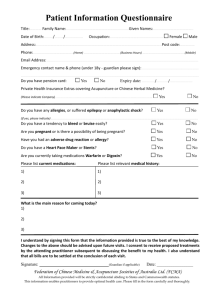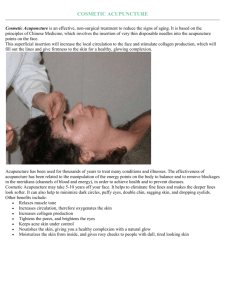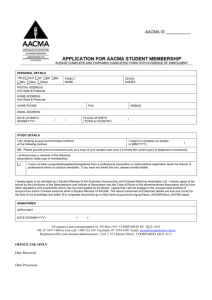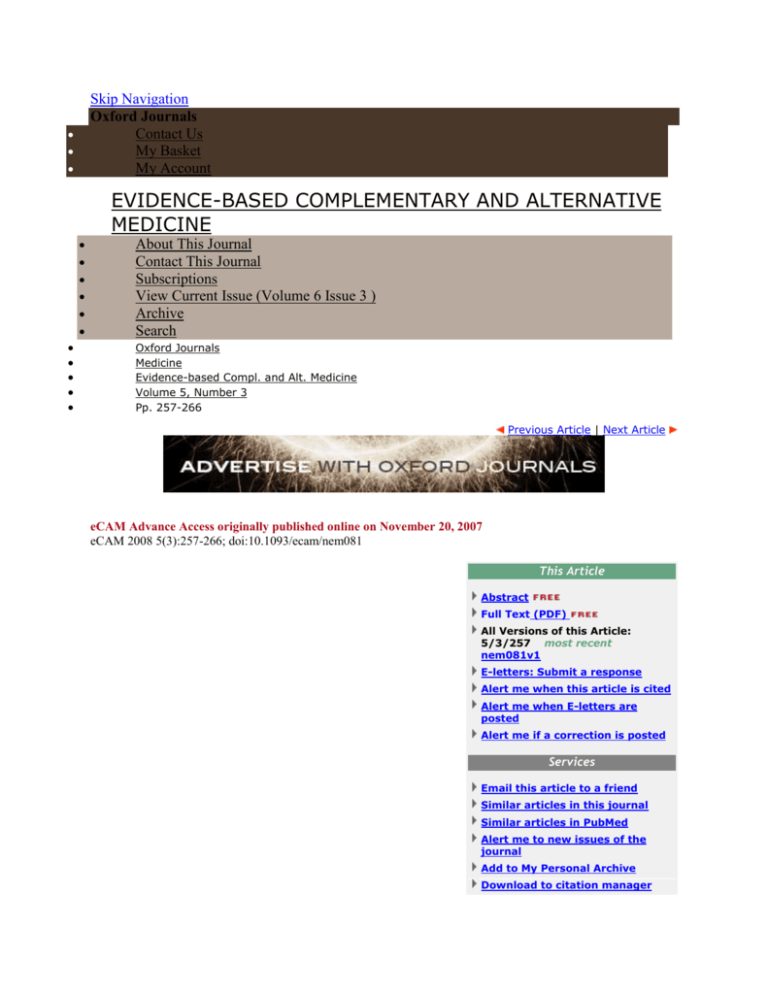
Skip Navigation
Oxford Journals
Contact Us
My Basket
My Account
EVIDENCE-BASED COMPLEMENTARY AND ALTERNATIVE
MEDICINE
About This Journal
Contact This Journal
Subscriptions
View Current Issue (Volume 6 Issue 3 )
Archive
Search
Oxford Journals
Medicine
Evidence-based Compl. and Alt. Medicine
Volume 5, Number 3
Pp. 257-266
Previous Article | Next Article
eCAM Advance Access originally published online on November 20, 2007
eCAM 2008 5(3):257-266; doi:10.1093/ecam/nem081
This Article
Abstract
Full Text (PDF)
All Versions of this Article:
5/3/257 most recent
nem081v1
E-letters: Submit a response
Alert me when this article is cited
Alert me when E-letters are
posted
Alert me if a correction is posted
Services
Email this article to a friend
Similar articles in this journal
Similar articles in PubMed
Alert me to new issues of the
journal
Add to My Personal Archive
Download to citation manager
Request Permissions
© The Author 2007. Published by Oxford University Press. All rights
reserved. For Permissions, please email:
journals.permissions@oxfordjournals.org
Google Scholar
Articles by Yang, C. H.
Articles by Sohn, S. H.
Search for Related Content
Review
A Possible Mechanism Underlying
the Effectiveness of Acupuncture in
the Treatment of Drug Addiction
Chae Ha Yang1, Bong Hyo Lee2 and Sung Hoon Sohn2
PubMed
PubMed Citation
Articles by Yang, C. H.
Articles by Sohn, S. H.
Social Bookmarking
What's this?
1
Department of Physiology and 2Department of
Acupuncture, Moxibution and Acupointology, College of Oriental Medicine, Daegu Haany
University, Daegu, 706-828, South Korea
Top
Abstract
Introduction
Physiological Basis of Drug...
A Role for Brain...
Acupuncture and the Negative...
Acupuncture and the Positive...
Conclusion
Acknowledgements
References
Abstract
Clinical trials are currently underway to determine the effectiveness of acupuncture in the
treatment of drug addiction. While there are still many unanswered questions about the basic
mechanisms of acupuncture, some evidence exists to suggest that acupuncture can play an
important role in reducing reinforcing effects of abused drugs. The purpose of this article is to
critically review these data. The neurochemical and behavioral evidence showed that
acupuncture's role in suppressing the reinforcing effects of abused drugs takes place by
modulating mesolimbic dopamine neurons. Also, several brain neurotransmitter systems such as
serotonin, opioid and amino acids including GABA have been implicated in the modulation of
dopamine release by acupuncture. These results provided clear evidence for the biological effects
of acupuncture that ultimately may help us to understand how acupuncture can be used to treat
abused drugs. Additional research using animal models is of primary importance to
understanding the basic mechanism underlying acupuncture's effectiveness in the treatment of
drug addiction.
Keywords: acupoint – drug abuse – mesolimbic dopamine system – opioid reward system
Top
Abstract
Introduction
Physiological Basis of Drug...
A Role for Brain...
Acupuncture and the Negative...
Acupuncture and the Positive...
Conclusion
Acknowledgements
References
Introduction
Acupuncture, arguably the most well-known alternative medicine treatment, has been an
important therapy in Eastern countries for thousands of years. Although introduced relatively
recently, acupuncture has gained popularity and greater acceptance as a treatment option in
Western countries.
In oriental medicine, the human body is considered to be a complex network of intricately related
processes played upon by opposing forces (Yin and Yang). Health is viewed as the maintenance
of balance and harmony between Yin and Yang, while illness is an expression of unbalance and
disharmony between Yin and Yang (1). Acupuncture is an important treatment modality in
manipulating and balancing Yin and Yang. Acupuncture involves the stimulation of specific
points on the skin, usually by the insertion of metallic needles; however, related techniques such
as manual, electrical or laser stimulation of acupuncture points are also often summarized under
this term. In its original form, acupuncture was based on the principles of traditional oriental
medicine. In oriental medicine, health is understood in terms of a vital force or energy called
‘Qi’, a metaphysical concept, which circulates between the organs along hypothesized channels
called meridians. On these ‘meridians’, there are 365 designated acupuncture points that can be
used for stimulation through needles or ‘moxibustion’ to balance and harmonize Yin and Yang by
relieving blockages in the flow of ‘Qi’. Qi energy must flow in the correct strength and quality
through each of these meridians and organs for health to be maintained. The acupuncture points
are located along the meridians and provide one means of altering the flow of Qi. Thus, the
supposed principle of acupuncture in oriental medicine is correcting the unbalanced and
disharmonized flow of Qi by stimulating the relevant points on the body surface (2,3).
Conformation of acupuncture's role for homeostasis by manipulating and balancing Yin and Yang
was shown, when the body's innate homeostatic potentialities are overwhelmed by acute-or
chromic-stress conditions (4).
Complementary therapies are widely used throughout the world, but in fact their effectiveness is
quite controversial (5,6). Among them, acupuncture is one of the spotlighted treatments on the
field of illness which is hard to cure in the modern western medicine. Acupuncture as a
therapeutic intervention has been widely practiced for the treatment of many functional disorders
including substance abuse and mental illness in Eastern countries through diverse methods such
as manual acupuncture, electroacupuncture and acupoint nerve stimulation (7). Importantly,
acupuncture has become a standard procedure in many detoxification programs for drugs,
worldwide (8,9). While more scientific studies are needed to confirm the efficacy and define the
physiological mechanisms of acupuncture, the National Institutes of Health Consensus
Development Panel issued a report in 1977 stating ‘Acupuncture may be useful as an adjunct
treatment or an acceptable alternative or be included in a comprehensive management program’
(10). Also, in 1997, a consensus panel issued by the NIH cautiously concluded that acupuncture
might be efficacious in the treatment of post-operative and chemotherapy nausea and vomiting,
nausea of pregnancy and post-operative dental pain, including drug addiction (11).
Addiction treatment programs increasingly use a combination of conventional and
complementary/alternative medicine (CAM) method as acupuncture. Many studies in
acupuncture have used auricular acupuncture for the treatment of addictions in patients,
stimulating on a 3–4 point including Shenmen auricular point. However, the clinical data
obtained from effects of auricular acupuncture for drug addiction have not been consistent.
Several works have shown that auricular acupuncture did not provide significant contribution
over, and above, that achieved by conventional treatment alone in reduction of alcohol and
cocaine use (12,13) and was not more effective than needle insertion at control point in reducing
cocaine use (14). The existing data fail to document the benefit of acupuncture in treating
cocaine addiction as the sole treatment at this time. However, some evidence exists to suggest
that acupuncture can be beneficial in the treatment of cocaine addiction as an adjunctive therapy
(13). Importantly, there is considerable evidence to support that electroacupuncture at body
points is also particularly effective in alleviating the withdrawal syndrome in heroin addicts
(15,16). These findings are intriguing in light of the fact that recent clinical studies have brought
the search for the difference between body and auricular points in the efficacy of acupuncture in
the treatment of drug addiction.
Only a few experiments using animal models have been performed to determine the basic
mechanisms underlying acupuncture's effectiveness in the treatment of drug addiction.
Unfortunately, very little is known about the effects of acupuncture in a situation where drugs of
abuse are used on a chronic basis and how chronic use of drug effects both neurochemical and
behavioral changes. However, it has been generally accepted that acupuncture treatment can
contribute to the biochemical balance in the central nervous system and maintenance or recovery
of homeostasis (17,18). Additionally, results of some animal studies regarding drug addiction
have provided evidence for the involvement of neurotransmitters in the action of acupuncture
(19). Additional research using animal models is of primary importance to understanding the
basic mechanisms of acupuncture. The present article will explore studies directed at elucidating
the neurobiological mechanism of acupuncture on drug addiction with focus on Yin and Yang
theory.
Top
Abstract
Introduction
Physiological Basis of Drug...
A Role for Brain...
Acupuncture and the Negative...
Acupuncture and the Positive...
Conclusion
Acknowledgements
References
Physiological Basis of Drug Addiction
Role of Dopamine
The mesolimbic dopamine system originates in the ventral tegmental area (VTA) and projects to
regions that include the nucleus accumbens and prefrontal cortex. Dopamine is believed to be the
final common pathway for drugs such as cocaine, morphine and alcohol. The neurobiological
substrate for self-administration of all addictive drugs by animals and drug abuse in humans is
believed to, in some way, involve the dopamine system of the nucleus accumbens, a primitive
structure that is one of the brain's important pleasure centers. Dopamine is believed by many to
be directly responsible for the exhilarating rush that reinforces the desire to take drugs in drug
addicts and plays a pivotal role in the development of drug addiction. These drugs of abuseinduced changes in brain levels of dopamine are associated with feelings of well being and
pleasure and provide positive reinforcement; contributing to the continued drug abuse (20–22).
Furthermore, repeated drug administration produces sensitization of extracellular dopamine
levels in the nucleus accumbens and behavioral sensitization in rats, as evidenced by an enhanced
locomotor response and increased dopamine release in brain (23,24). Conversely, withdrawal
from chronic drug administration produced a reduction in dopamine outflow in the nucleus
accumbens (25–27). As suggested by many studies, drug-induced dopamine depletion in the
mesolimbic system may represent the mechanism, at least in part, underlying dysphoria and
anhedonia that accompanies drug withdrawal and might also contribute to the intense drug
craving experienced by addicts (28,29). These withdrawal-negative affects are largely associated
with negative reinforcement.
Although it is generally believed that the same neural systems are involved in drug reward and
drug-associated learning, there are two different theories that have opposite views on the role of
brain reward pathways in mediating drug-seeking behavior. One theory suggests that drug
seeking is triggered by drug-like, proponent processes that activate reward pathways in a manner
similar to acute effects of drug itself (30,31). Another theory suggests that drug-opposite or
opponent processes induce drug seeking by producing a hypofunctional state of reward pathways
which leads to dysphoria or anxiety during withdrawal (32). Yin and Yang theory may explain
these seemingly opposite proponent and opponent theories underlying drug addiction and relapse
to drug seeking. Koob and Moal Le (33) proposed a conceptual framework of allostasis which
focused on abnormal changes in reward function that lead to excessive drug taking and drug
seeking in prolonged withdrawal. The allostasis model has been proposed for brain changes that
occur during the development of addiction process and explains the persistent vulnerability to
relapse long after drug taking has ceased. During the course of addiction, counter-adaptive
processes such as opponent process that are usually part of normal homeostatic limitation of
reward function fails to return to normal range and it is hypothesized to form an allostatic state.
The allostasis model shares a similar concept on reward with Yin and Yang theory, from the
standpoint of understanding that both theories explain the homeostasis and balance between
positive and negative impact on drug addiction.
Modulation of Dopamine Neuron by GABA and Opioids
The firing activity of dopamine neuron is controlled by the intrinsic activity of the neuron as well
as the inhibitory and excitatory input, which it receives from other brain structures as well as
from local GABA interneurons in the VTA. GABA can interact with either GABAA or GABAB
receptors present in the VTA. While GABAergic neurons are known to dampen dopamine
neurons via inhibitory GABAA or GABAB receptors in the VTA dopamine neurons (34,35),
recent findings suggest that GABAB receptors play a predominant role in attenuating the
reinforcing effects of the drugs through a modulation of dopamine transmission. For example, it
has been shown that the GABAB antagonist SCH 50911 blocked gamma-vinyl GABA's
inhibition of cocaine-induced increases in dopamine in the nucleus accumbens (36). A similar
conclusion was obtained in another study in which GABAB receptor agonist baclofen dose
dependently reduced heroin-induced dopamine release in the nucleus accumbens and inhibited
heroin self-administration behavior (37). Therefore, it is highly likely that GABAB receptor
stimulation is sufficient to dampen nucleus accumbens dopamine release induced by abused
drugs. Chronic cocaine or amphetamine is associated with altered GABAB receptor function after
withdrawal (38). Importantly, the observed increase in GABAB heteroreceptor function would be
expected to lead to decreased dopamine and glutamate release in the VTA, and may therefore
contribute to the reward deficits associated with psychostimulant withdrawal (38). Moreover,
chronic administration of ethanol enhanced the baseline activity of VTA GABA neurons
underlying the decrease in accumbal dopamine release associated with withdrawal from chronic
ethanol (39). It has been shown that probability of GABA release in the VTA area is increased
during withdrawal from morphine (40). In contrast, chronic exposure to cocaine decreased the
functional coupling of GABAB receptors to G-proteins in the VTA in rats, suggesting that
cocaine sensitization implicates the enhanced extracellular dopamine levels in the nucleus
accumbens (41). There is some direct support for this finding in studies of in vivo microdialysis
showing that endogenous GABA release was reduced in the striatum of rats sensitized to cocaine
(42). Taken together, these results suggest that neurochemical and behavioral sensitization may
imply a decreased ability of GABAB receptors to inhibit dopaminergic activity.
Activation of µ- and -opioid receptors is known to exert opposite modulation of dopamine
neuron in the mesolimbic dopamine system (43,44). The µ-opioid receptors are selectively
expressed on inhibitory GABA interneurons in the VTA. Activation of µ-receptors
hyperpolarizes these GABAergic neurons, causing a disinhibition of the dopamine neurons (45).
As a consequence, this leads to the increased accumbal dopamine release. Conversely, -receptor
is located on presynaptic dopaminergic nerve terminals in the nucleus accumbens. The -receptor
agonist inhibits the dopaminergic neuron directly, resulting in the decrease of accumbal
dopamine release (46). Supporting the notion that suppression of GABAergic input onto
dopaminergic neurons in the VTA contributes to µ-opioid receptor modulation of cocaine
reinforcement, µ-opioid receptor knockout mice showed the reduced cocaine self-administration
and increased GABAergic input to VTA dopaminergic neurons (47). A role for -receptor in
dopamine release in the nucleus accumbens was extended by the observation that inhibition of opioid receptor by -opioid receptor knockout and the -opioid receptor antagonist
norbinaltorphimine produced ethanol-induced elevation of extracellular dopamine in the nucleus
accumbens, respectively (48,49). Also, recent work has shown that blockade of -opioid receptor
increased alcohol drinking in two bottle choice paradigm, suggesting that -opioid receptor may
be particularly important for the blockade of the reinforcing effect of ethanol via inhibition of
dopaminergic neuron (50).
Top
Abstract
Introduction
Physiological Basis of Drug...
A Role for Brain...
Acupuncture and the Negative...
Acupuncture and the Positive...
Conclusion
Acknowledgements
References
A Role for Brain Neurotransmitters in the Action of
Acupuncture
All studies measuring neurochemical responses to acupuncture provided evidence for the
biological effects of acupuncture that ultimately may help to understand how acupuncture can be
used to treat disease. Moreover, in a more general sense, these results suggest that acupuncture
can correct reversible malfunctions of the body by direct activation of brain pathways and thus
contribute to the biochemical balance in the central nervous system by regulating
neurotransmitters that control health and disease. The discovery of the central endorphin system
was a prominent step toward understanding the analgesic effect of acupuncture (51,52). It is now
well established that endorphinergic neurons in the hypothalamus projecting to the dosal raphe
nucleus and periaqueductal gray matter of the mesencephalon are primarily responsible for
acupuncture analgesia (53). Additionally, other brain areas such as the nucleus accumbens, with
interconnections to the descending pathway from the hypothalamus to the dorsal raphe nucleus
and periaqueductal gray matter, might also mediate opioid- and acupuncture-induced analgesia
(54,55). In the nucleus accumbens, drugs of abuse act to produce a large increase in dopamine
that has long been associated with addictive behavior (56). The descending antinoceptive
pathway from the hypothalamus appears to depend on the activation of the anterolateral tract by
acupuncture (57). Also, several brain neurotransmitter systems such as serotonin, catecholamines
and amino acids including GABA have been implicated in the analgesic effects of acupuncture
(58).
Although few experiments have investigated the effect of acupuncture on GABAergic neuron,
GABA-related studies provided evidence that acupuncture stimulation may produce the
inhibitory effect via GABAergic neuron. For example, it has been shown that electroacupuncture
exerted depressor effect by inhibition of the sympathetic nervous system and this effect was
mediated through GABA in the rostral ventrolateral medulla. This inhibitory effect via
GABAergic neuron was reversed with injection of GABA antagonist (59,60). GABA has also
been implicated in the therapeutic effect of cerebral ischemia by electroacupuncture using middle
cerebral artery occlusion (MCAO) rats. Electroacupuncture effectively reduced infarct area in the
cerebral cortex and hippocampus and increased GABA immunoreactivity. Inhibition of infarction
by electroacupuncture was completely prevented by a GABA receptor's antagonist (61).
With regard to serotonin, microdialysis study showed that acupuncture at bilateral Shenshu
acupoints significantly increased serotonin release in the rat nucleus accumbens (62). The authors
suggested the possibility that acupuncture affect the reward system pathway of the brain by
activation of serotonergic neurons. Further support for a role of acupuncture in regulating brain
serotonin is the observation that electroacupuncture prevented restraint-induced decreases in
serotonin levels in the nucleus accumbens (63). Serotonin has long been hypothesized to have a
role in mediating the efficacy of acupuncture in the treatment of drug withdrawal (64).
Considerable evidence showed marked differences between the alcohol-preferring rats and
normal rats in that the alcohol-preferring rats have fewer serotonin neurons and higher levels of
enkephalin in the hypothalamus, fewer GABA neurons, lower dopamine release and dopamine
D2 receptors in the nucleus accumbens (65–68). Based on these observations, it was postulated
that chronic exposure to drugs might cause ‘reward deficiency syndrome’ resulting from a basal
dysfunction of brain reward dopamine function. These authors proposed that activation of
serotonin neurons in the hypothalamus induces met-enkephalin release in the VTA, and as a
consequence, GABA neurons in the VTA are inhibited, thereby increasing dopamine release in
the nucleus accumbens (69). This proposal, combined with the finding that acupuncture activates
the descending serotonergic pathways via the anterolateral tract (57), have suggested that
acupuncture may have a role in normalizing the release of dopamine via serotonin neurons in the
hypothalamus (64).
Top
Abstract
Introduction
Physiological Basis of Drug...
A Role for Brain...
Acupuncture and the Negative...
Acupuncture and the Positive...
Conclusion
Acknowledgements
References
Acupuncture and the Negative Reinforcing Effect of
Abused Drugs
Role of the Mesolimbic Dopamine System in Acupuncture
Although there is a lack of well-controlled experiments investigating the effect of acupuncture on
drug abuse, including ethanol, a few studies using animal models have provided evidence that
acupuncture can play an important role in reducing negative reinforcing effects of drug.
Electroacupuncture at the specific point ST36 effectively reduced the increase in alcoholdrinking behavior and enhanced the striatal dopamine level in rats challenged with
immobilization stress (70). While ethanol has diverse effects in the brain, ethanol has been shown
to increase the firing rates of mesolimbic dopamine neurons by modulating GABAA receptors
located on GABAergic neurons in the VTA (71). Ethanol has stimulatory, euphoric, sedation,
anxiolytic and muscle relaxant effects. Even though all these diverse effects probably cannot be
related to one specific single neurotransmitter, dopamine seems to be involved in most of the
effects. During ethanol withdrawal, brain stimulation reward thresholds were elevated compared
to pre-drug baseline (72). This elevation in reward threshold may reflect an anhedonia state and
as such it may be homologous to the anhedonia reported by alcohol-dependent patients (73,74).
A likely neurochemical mechanism involved in this withdrawal state would be some hypoactivity
of dopamine functioning. It has also been shown that withdrawal from chronic ethanol
administration can produce a reduction in dopamine outflow in the nucleus accumbens (75).
Based on the earlier facts, these results, combined with observations of dopamine levels in the
striatum, suggest that the suppression of alcohol-drinking behavior by electroacupuncture may be
mediated by the increase of striatal dopamine levels.
Recent studies have shown that acupuncture attenuated alcohol withdrawal syndrome and Foslike immunoreactivity (FLI) in the striatum and the nucleus accumbens core of rats. During 3
days of cessation following chronic administration of ethanol, rats showed a significant increase
in alcohol withdrawal syndrome, such as hypermotility, tail rigidity, grooming and tremor and
increase in FLI in the dopamine terminal areas in the brain, reflecting the expected increases in
neuronal excitability. Treatment of acupuncture at Zusanli or Sanyinjiao points during
withdrawal period inhibited AWS and also prevented the expected increase in FLI of rats
exposed to chronic ethanol. These results suggest that acupuncture may be effective in
suppressing alcohol withdrawal syndrome by modulating post-synaptic neural activation in the
striatum and nucleus accumbens core (76). Similar to these results, a recent study showed that
electroacupuncture decreased both c-Fos gene expression in the central nucleus of the amygdala
and withdrawal signs in morphine-withdrawn rats (77). Amygdala and nucleus accumbens play
an important role for the motivational effect of opiate withdrawal. Given that the increase of cFos gene expression in the central nucleus of amygdala is associated with the negative
motivational impact on drug addiction, one possibility is that acupuncture could help to
normalize neuronal activation and thereby reverse withdrawal signs.
Acupuncture and Cerebral Endogenous Opioid System
The ‘Incentive-sensitization theory’ proposes that enhanced mesocorticolimbic dopamine
neurotransmission is currently recognized as a common target of the dependence-producing
properties of opioids, psychostimulants and alcohol (78). Previous work has suggested cerebral
β-endorphin system may be involved in reward. Additionally, cerebral β-endorphin originates in
the arcuate nucleus of the mediobasal hypothalamus and projects to limbic structures such as the
VTA and the nucleus accumbens, seems to be responsible for the reinforcing effects of abused
drugs (79). A hypothetical model has been proposed for possible interactions between the
endogenous opioid reward system and the release of dopamine from the nucleus accumbens.
VTA GABA interneurons connect to VTA dopamine neurons and likely inhibit them. Activation
of presynaptic µ-opioid receptors on these GABAergic interneurons decreases the firing rate of
VTA GABA neurons, leading to an increase in release of dopamine in the nucleus accumbens,
whereas presynaptic -opioid receptors in the nucleus accumbens directly inhibit dopamine
release in the nucleus accumbens. β-endorphin released from fibers ascending from the arcuate
nucleus of the hypothalamus stimulates µ-receptors in the VTA, thereby disinhibiting VTA
dopamine neurons. Also, it activates -opioid receptors in the nucleus accumbens. Thus, βendorphin increases dopamine release in the nucleus accumbens (Fig. 1) (80). Several
experiments have investigated the effect of electroacupuncture on endogenous opioid system.
These opioid-related studies, using animal models, have provided evidence that low-frequency
electroacupuncture can activate enkephalinergic and β-endorphinergic neurons in the nucleus
arcuatus of the hypothalamus (81,82). Accordingly, it seems reasonable to propose that
electroacupuncture may help to enhance the release of dopamine in the nucleus accumbens via opioid receptors in the nucleus accumbens as well as µ-receptors in the VTA. In addition, there is
an important neurochemical evidence that acupuncture treatment directly affects the mesolimbic
dopamine system. Acupuncture treatment at the specific acupoints Shenmen (HT7) significantly
prevented a decrease of extracellular dopamine levels in the nucleus accumbens after withdrawal
from chronic ethanol administration, with an accumbal dopamine concentration restored to
approximately 90% of that of naïve animal (83). Given chronic ethanol-induced dopamine
depletion in the mesolimbic system is linked to the dysphoria and anhedonia that often
accompanies ethanol withdrawal (84), acupuncture may play a role in relieving withdrawal
syndrome and help to prevent compulsive drug-seeking behavior and relapse.
Figure 1. A hypothetical model of possible bidirectional
effects of acupuncture on dopamine release in the nucleus
accumbens. In positive reinforcement, acupuncture
treatment activates GABAB receptors on the dopamine cell
bodies, resulting in a decrease of dopamine release in the
nucleus accumbens through the inhibition of dopaminergic
neurons; additionally, acupuncture activates presynaptic opioid receptors in the nucleus accumbens through
dynorphin neurons, resulting in a decrease of dopamine
release in the nucleus accumbens. In negative
View larger version (24K): reinforcement, acupuncture treatment stimulates
[in this window]
enkephalin neurons in the hypothalamus, such that
[in a new window]
methionine-enkephalin released in the VTA interacts with
[Download PowerPoint slide] µ-opioid receptors to inhibit VTA GABAergic
interneurons, inducing the disinhibition of dopaminergic
neurons and thus, eventually increases the dopamine
release in the nucleus accumbens.
Animal models for the acute reinforcing effects of abused drugs have included measures of
preference for the environment paired with drug administration (conditioned place preference;
CPP). Further support for a role of brain β-endorphin is the observation that low-frequency
electroacupuncture reduced morphine-induced place preference in rats and this effect was
reversed by pretreatment of opioid receptor antagonist naloxone at a small dose which is
sufficient to block the opioid µ and , but not the , receptors (85). The authors suggested that µopioid receptor might be involved in acupuncture's role in suppressing the negative reinforcing
effect of morphine. In this study, since CPP paradigm was carried out 24 h after the last daily
injection, the negative stimulus effects of acute morphine withdrawal may be responsible for the
preference to the drug-pairing environment. Thus, it is possible that electroacupuncture reduces
the negative stimulus effects by activation of dopamine release through β-endorphinergic and
enkephalinergic neurons in the brain, especially in the arcuate nucleus. On the other hand, one
behavioral study has indicated that high-frequency electroacupuncture suppressed the naloxoneinduced morphine withdrawal syndrome and this effect was reversed by pretreatment with
dynorphin A antibody or -receptor antagonist (86).
The neuropharmacological data reviewed earlier, provide some evidence for the action of the
endogenous opioid peptides in acupuncture analgesia. On the basis of these and other findings
that low-frequency electroacupuncture facilitates the release of β-endorphin and enkephalin in
the CNS, whereas high-frequency electroacupuncture produced an increase in dynorphin release
(87,88), it has been expected that low-frequency electroacupuncture can play a predominant role
in attenuating withdrawal syndrome by activating the β-endorphinergic and enkephalinergic
neurons. However, high-frequency electroacupuncture was more effective in suppressing
morphine withdrawal syndrome compared to low-frequency electroacupuncture (89). The exact
neurochemical mechanisms mediating the suppressive effect of high-frequency
electroacupuncture on withdrawal syndrome is unknown but these results suggest the possibility
that electroacupuncture's role in suppressing the morphine withdrawal syndrome takes place by
activating the -opioid receptor and dynorphin release. To summarize the research described
earlier, low-frequency electroacupuncture appears to play a critical role in attenuating the
motivational aspects of drug withdrawal, while high-frequency electroacupuncture may be most
effective in reducing withdrawal symptoms.
Top
Abstract
Introduction
Physiological Basis of Drug...
A Role for Brain...
Acupuncture and the Negative...
Acupuncture and the Positive...
Conclusion
Acknowledgements
References
Acupuncture and the Positive Reinforcing Effect of
Abused Drugs
Role of -opioid Receptor in Acupuncture
A number of studies with rats have shown that acupuncture attenuates rewarding effects induced
by drugs of abuse. Recent work using injections of selective opioid receptor antagonists has
shown that -receptor may be particularly important for the inhibitory effect of high-frequency
electroacupuncture on the expression of morphine-induced CPP and cocaine-induced CPP
(90,91). High-frequency electroacupuncture increases dynorphin release to interact with receptor in brain (92). A similar observation was obtained in another study in which highfrequency electroacupuncture enhanced the expression of mRNA encoding predynorphin in brain
(93). Recent studies have demonstrated that dynorphin causes the decrease in dopamine release
within the nucleus accumbens through an action on -opioid receptors that are located on
presynaptic dopaminergic nerve terminals in this region (93,94). Furthermore, behavioral studies
reported that -opioid receptor agonists decrease cocaine and heroin self-administration (95,96).
Therefore, it has been suggested that high-frequency electroacupuncture stimulation is sufficient
to dampen morphine-induced CPP through -opioid receptor. Roles for enkephalin and
dynorphin in the mechanisms underlying the inhibitory effect of electroacupuncture has been
replicated using morphine-induced CPP and reinstatement of extinguished CPP (97).
Preproenkephalin or preprodynorphin mRNA levels in the nucleus accumbens were increased,
respectively, in rats shown to suppress morphine-induced CPP and reinstatement of extinguished
CPP after low- or high-frequency electroacupuncture.
Inhibition of Dopamine Release by Acupuncture
There is evidence that the enhancement of dopamine transmission in the nucleus accumbens
induced by all addictive drugs is linked to its reinforcing properties and may be implicated in the
development of behavioral sensitization (98,99). This persistent phenomenon, referred to by
some as sensitization, is thought to play a major role in magnifying the positive-reinforcing
properties of a subsequent drug challenge and represent the mechanism, at least in part,
underlying the reinstatement of drug-seeking behavior (100). Thus, there is lot of interest in
gaining a better understanding of how acupuncture works in the brain to influence addictive
behaviors. Few studies were designed to investigate the effect of acupuncture on extracellular
dopamine levels using in vivo microdialysis and behavioral changes in rats treated by repeated
drugs, including morphine and alcohol after drug withdrawal followed by drug challenge. Results
showed that systemic challenge with drug produced neurochemical and behavioral sensitization
indicating a much larger increase in dopamine and behavioral activity compared to salinepretreated rats. Most importantly, these results demonstrated that even brief (1 min) acupuncture
treatments prevented to a great extent, drug-induced elevation in dopamine levels in the nucleus
accumbens and also reduced the amount of drug-induced behavioral hyperactivity (19,83). In
view of the fact that enhanced dopamine transmission in the nucleus accumbens induced by all
addictive drugs has long been associated with addictive behaviors, these results suggest that
reduction in behavioral activity by acupuncture may be mediated by attenuation of dopamine
release and neuronal activity in the nucleus accumbens. Moreover, in a more general sense these
results suggest that minimizing sensitization may be one of mechanisms whereby acupuncture
reduces drug craving in addicts.
Fewer studies have been performed to determine the basic mechanism underlying acupuncture's
effectiveness in reducing dopamine release induced by the drugs. One study used rats to
investigate the possible mechanism of acupuncture on the GABAB pathway. Rats were
administered with the highly selective GABAB antagonist SCH 50911 prior to an intraperitoneal
injection of ethanol. Immediately after ethanol treatment, acupuncture was administered for 1
min. Acupuncture at the specific acupoint HT7, but not at control points (PC6 or tail)
significantly decreased dopamine release in the nucleus accumbens. Inhibition of dopamine
release by acupuncture was completely prevented by SCH 50911 (101). GABAergic neurons are
known to dampen dopamine neurons via inhibitory GABAB receptors in the mesolimbic
dopamine system (102). Recently, the GABAB receptor agonist reduced reinforcing properties of
ethanol (103). These earlier-mentioned results suggest that stimulation of specific acupoints
inhibits ethanol-induced dopamine release by modulating GABAB activity and implies that
acupuncture may be effective in blocking the reinforcing effects of ethanol (Fig. 1).
As with cocaine, amphetamines and morphine, addiction to nicotine is believed to result from
increased release of dopamine in the region of nucleus acumbens (104,105). One study reported
the effect of acupuncture on behavioral locomotor activity and c-fos expression in the nucleus
accumbens and striatum utilizing the immunocytochemical detection of the Fos protein in
nicotine-sensitized rats. Similar to morphine or ethanol-sensitized rats, acupuncture significantly
attenuated expected increase in nicotine-induced locomotor activity and FLI in the nucleus
accumbens and striatum to subsequent nicotine challenge (106). These findings suggest that
acupuncture produces a therapeutic effect on nicotine addiction, possibly by modulating postsynaptic neuronal activity in the nucleus accumbens and the striatum.
Top
Abstract
Introduction
Physiological Basis of Drug...
A Role for Brain...
Acupuncture and the Negative...
Acupuncture and the Positive...
Conclusion
Acknowledgements
References
Conclusion
Clinical trials are currently underway to determine the effectiveness of acupuncture in treating
drug addiction (15,107). Yet, there are still many unanswered questions about the basic
mechanisms of acupuncture. Additional research using animal models is of primary importance
in understanding the basic mechanisms of acupuncture. Chronic exposure to drugs of abuse
produces a withdrawal state as reflected in increases in brain reward thresholds, and this change
in reward threshold appears in be opposite to actions of the drug administered acutely. These
opposite proponent and opponent processes during the development of drug addiction may
contribute to the intense drug craving experienced by addicts. Based largely on animal selfadministration, the reinforcing effects of drugs have been linked to central dopamine activity in
the mesolimbic dopamine system. While little is known about the basic mechanism of
acupuncture in treating drug addiction, the neurochemical and behavioral data reviewed earlier
showed that acupuncture directly or indirectly affects the mesolimbic dopamine system. These
results suggest that acupuncture helps to maintain the homeostasis and balance between positive
and negative processes involved in drug addiction. Moreover, in a more general sense, these
results suggest that acupuncture can be used as a therapeutic intervention for correcting
reversible malfunction of the body by directing brain pathways and thus contributes to balance in
the central nervous system by regulating neurotransmitters. Future studies should determine if
acupuncture therapy can influence any of the other neurotransmitters (GABA and glutamate)
believed to play a role in regulating dopamine release. It would also be interesting to assess the
effect of acupuncture on drug reward thresholds in animals trained to self-administer drugs of
abuse.
Footnotes
For reprints and all correspondence: Chae Ha Yang, Department of Physiology, College of
Oriental Medicine, Daegu Haany University, 165 Sang-Dong, Suseong-Gu, Daegu, 706-828,
South Korea. Tel: +82-53-770-2239; Fax: +82-53-770-2278; E-mail: chyang@dhu.ac.kr
Top
Abstract
Introduction
Physiological Basis of Drug...
A Role for Brain...
Acupuncture and the Negative...
Acupuncture and the Positive...
Conclusion
Acknowledgements
References
Acknowledgements
The authors are grateful to Mr George Smith for the language editing of the manuscript. This
work was supported by a grant (R12-2003-002-03001-0) from the basic research program of the
Ministry of Commerce, Industry and Energy, Korea.
References
1. Dale R. The origins and future of acupuncture. Am J
Acupunct ( 1982;) 10:: 101–20.[Web of Science]
2. George AU, Han SP, Han JS. Elecroacupuncture:
mechanisms and clinical application. Soc Biol
Psychiatry ( 1998;) 44:: 129–38.[CrossRef]
Top
Abstract
Introduction
Physiological Basis of Drug...
A Role for Brain...
Acupuncture and the Negative...
Acupuncture and the Positive...
Conclusion
Acknowledgements
References
3. Vickers A, Wilson P, Kleijnen J. Acupuncture. Qual
Saf Health Care ( 2002;) 11:: 92–7.[Abstract/Free Full Text]
4. Walling A. Therapeutic modulation of the psychoneuroimmune system by medical
acupuncture creates enhanced feelings of well-being. J Am Acad Nurse Pract ( 2006;)
18:: 135–43.[CrossRef][Web of Science][Medline]
5. Eisenberg DM, Davis RB, Ettner SL, Appel S, Wilkey S, Van Rompay M, et al. Trends
in alternative medicine use in the United States, 1990–1997: results of a follow-up
national survey. JAMA ( 1998;) 280:: 1569–75.[Abstract/Free Full Text]
6. Harris P, Rees R. The prevalence of complementary and alternative medicine use
among the general popluation: a systematic review of the literature. Complement Ther
Med ( 2000;) 8:: 88–96.[CrossRef][Web of Science][Medline]
7. Han JS, Trachtenberg AI, Lowinson JH. Acupuncture. In: Substance Abuse, A
Comprehensive textbook —Lowinson JH, Ruiz P, Millman RB, Langrod JG, eds. (
2005;) Philadelphia: PA.
8. Avants SK, Margolin A, Chang P, Kosten TR, Birch S. Acupuncture for the treatment
of cocaine addiction: investigation of a needle puncture control. J Subst Abuse Treat (
1995;) 12:: 195–205.[CrossRef][Web of Science][Medline]
9. Shwartz M, Saitz R, Mulvey K, Brannigan P. The value of acupuncture detoxification
programs in a substance abuse treatment system. J Subst Abuse Treat ( 1999;) 17::
305–12.[CrossRef][Web of Science][Medline]
10. Anonymous. Acupuncture. NIH consensus statement. JAMA ( 1998;) 280:: 1518–
24.[Abstract/Free Full Text]
11. Anonymous. Acupuncture. NIH consensus statement ( 1997;) 15:: 1–34.[Medline]
12. Bullock ML, Kiresuk TJ, Sherman RE, Lenz SK, Culliton PD, Boucher TA, et al. A
large randomized placebo controlled study of auricular acupuncture for alcohol
dependence. J Subst Abuse Treat ( 2002;) 22:: 71–7.[CrossRef][Web of
Science][Medline]
13. Kim YH, Schiff E, Waalen J, Hovell M. Efficacy of acupuncture for treating cocaine
addiction: a review paper. J Addict Dis ( 2005;) 24:: 11–132.
14. Margolin A, Kleber HD, Avants SK, Konefal J, Gawin F, Stark E, et al. Acupuncture
for the treatment of cocaine addiction: a randomized controlled trial. JAMA ( 2002;)
287:: 55–63.[Abstract/Free Full Text]
15. Zeng X, Lei L, Lu Y, Wang Z. Treatment of heroinism with acupuncture at points of
the Du Channel. J Tradit Chin Med ( 2005;) 25:: 166–70.[Medline]
16. Zhang B, Luo F, Liu C. Treatment of 121 heroin addicts with Han's acupoint nerve
stimulator. Zhonguo Zhong Xi Yi Jie He Za Zhi ( 2000;) 20:: 593–5.
17. Zhao CH, Stillman MJ, Rozen TD. Traditional and evidence-based acupuncture in
headache management: theory, mechanism, and practice. Headache ( 2005;) 45:: 716–
30.[CrossRef][Web of Science][Medline]
18. Otto KC. Acupuncture and substance abuse: a synopsis, with indications for further
research. Am J Addict ( 2003;) 12:: 43–51.[Web of Science][Medline]
19. Kim MR, Kim SJ, Lyu YS, Kim SH, Lee YK, Kim TH, et al. Effect of acupuncture on
behavioral hyperactivity and dopamine release in the nucleus accumbens in rats
sensitized to morphine. Neurosci Lett ( 2005;) 387:: 17–21.[CrossRef][Web of
Science][Medline]
20. Weiss F, Paulus MP, Lorang MT, Koob GF. Increases in extracellular dopamine in the
nucleus accumbens by cocaine are inversely related to basal levels: effects of acute and
repeated administration. J Neurosci ( 1992;) 12:: 4372–80.[Abstract]
21. Carrelli RM, Deadwyler SA. Dose dependent transition in nucleus accumbens cell
firing and behavioral responding during cocaine self-administration sessions in rats. J
Pharmacol Exp Ther ( 1996;) 277:: 385–93.[Abstract/Free Full Text]
22. Peoples LL, Uzwiak AJ, Guyette FX, West MO. Tonic inhibition of single nucleus
accumbens neurons in the rat: a predominant but not exclusive firing pattern induced
by cocaine self-administration sessions. Neuroscience ( 1998;) 86:: 13–
22.[CrossRef][Web of Science][Medline]
23. Nestby P, Vanderschuren LJ, De Vries TJ, Hogenboom F, Wardehm G, Mulder AH, et
al. Ethanol, like psychostimulants and morphine, causes long-lasting hyperactivity of
dopamine and acetylcholine neurons of rat nucleus accumbens: possible role in
behavioral sensitization. Psychopharmacol ( 1997;) 133:: 69–76.[CrossRef][Medline]
24. Cadoni C, Solinas M, Di Chiara G. Psychostimulant sensitization: differential changes
in accumbal shell and core dopamine. Eur J Pharmacol ( 2000;) 388:: 69–
76.[CrossRef][Web of Science][Medline]
25. Rossetti ZL, Isola D, Vry De J, Fadda F. Effects of nimodipine on extracellular
dopamine levels in the rat nucleus accumbens in ethanol withdrawal. Neuropharmacol
( 1999;) 38:: 1361–5.[CrossRef][Web of Science][Medline]
26. Maisonneuve IM, Ho A, Kreek MJ. Chronic administration of a cocaine ‘binge’ alters
basal extracellular levels in male rats: an in vivo microdialysis study. J Pharmacol Exp
Ther ( 1995;) 272:: 652–7.[Abstract/Free Full Text]
27. Diana M, Pistils M, Muntini A, Gesso G. Mesolimbic dopaminergic reduction outlasts
ethanol withdrawal syndrome: evidence of protracted abstinence. Neuroscience (
1996;) 71:: 411–15.[CrossRef][Web of Science][Medline]
28. Weiss F, Porrino LJ. Behavioral neurobiology of alcohol addiction: recent advances
and challenges. J Neurosci ( 2002;) 22:: 3332–7.[Abstract/Free Full Text]
29. Wise RA, Newton P, Leeb K, Burnette B, Pocock DJB, Justice JB. Fluctuations in the
nucleus accumbens dopamine concentration during intravenous cocaine selfadministration in rats. Psychopharmacol ( 1995;) 120:: 10–20.[CrossRef][Medline]
30. Robinson TE, Berridge KC. The neural basis of drug craving: an incentivesensitization theory of addiction. Brain Res Rev ( 1993;) 18:: 247–
91.[CrossRef][Medline]
31. Self DW, Nestler EJ. Molecular mechanisms of drug reinforcement and addiction.
Annu Rev Neurosci ( 1995;) 18:: 463–95.[CrossRef][Web of Science][Medline]
32. Koob GF, Moal Le M. Drug abuse: hedonic homeostatic dysregulation. Science (
1997;) 278:: 52–8.[Abstract/Free Full Text]
33. Koob GF, Moal Le M. Drug addiction, dysregulation of reward, and allostasis.
Neuropsychopharmacol ( 2001;) 24:: 97–129.[CrossRef][Web of Science][Medline]
34. Westerink BHC, Enrico P, Feimann J, DeVries JB. The pharmacology of mesocortical
dopamine neurons: a dual-probe microdialysis study in the ventral tegmental area and
prefrontal cortex of the rat brain. J Pharmacol Exp Ther ( 1998;) 285:: 143–
54.[Abstract/Free Full Text]
35. Xi ZX, Stein EA. Nucleus accumbens dopamine release modulation by mesolimbic
GABAA receptors: an in-vivo electrochemical study. Brain Res ( 1998;) 798:: 156–
65.[CrossRef][Web of Science][Medline]
36. Ashby CR, Rohatgi R, Ngosuwan J, Borda T, Gerasimov MR, Morgan AE, et al.
Implication of the GABA(B) receptor in gamma vinyl-GABA's inhibition of cocaineinduced increases in nucleus accumbens dopamine. Synapse ( 1999;) 31:: 151–
3.[CrossRef][Web of Science][Medline]
37. Xi ZX, Stein EA. Baclofen inhibits heroin self-administration behavior and mesolimbic
dopamine release. J Pharmacol Exp Ther ( 1999;) 290:: 1369–
74.[Abstract/Free Full Text]
38. Giorgetti M, Hotsenpiller G, Froestl W, Wolf ME. In Vivo modulation of ventral
tegmental area dopamine and glutamate efflux by local GABA(B) receptors is altered
after repeated amphetamine treatment. Neuroscience ( 2002;) 109:: 585–
95.[CrossRef][Web of Science][Medline]
39. Diana M, Brodie M, Muntoni A, Puddu MC, Pillolla G, Steffensen S, et al. Enduring
effects of chronic ethanol in the CNS: basis for alcoholism. Alcohol Clin Exp Res (
2003;) 27:: 354–61.[CrossRef][Web of Science][Medline]
40. Bonci A, Williams JT. Increased probability of GABA release during withdrawal from
morphine. J Neurosci ( 1997;) 17:: 796–803.[Abstract/Free Full Text]
41. Kushner SA, Unterwald EM. Chronic cocaine administration decreases the functional
coupling of GABA(B) receptors in the rat ventral tegmental area as measured by
baclofen-stimulated 35S-GTP S binding. Life Sci ( 2001;) 69:: 1093–
102.[CrossRef][Web of Science][Medline]
42. Jung BJ, Dawson R Jr, Sealey SA, Peris J. Endogenous GABA release is reduced in
the striatum of cocaine-sensitized rats. Synapse ( 1999;) 34:: 103–10.[CrossRef][Web
of Science][Medline]
43. Mansvelder HD. Yin and Yang of VTA opioid signaling. Focus on ‘both kappa and mu
opioid agonists inhibit glutamatergic input to ventral tegmental area neurons’. J
Neurophysiol ( 2005;) 93:: 3046–7.[Free Full Text]
44. Margolis EB, Hjelmstad GO, Bonci A, Fields HL. Kappa-opioid agonists directly
inhibit midbrain dopaminergic neurons. J Neurosci ( 2003;) 23:: 9981–
6.[Abstract/Free Full Text]
45. Johnson SW, North RA. Opioids excite dopamine neurons by hyperpolarization of
local interneurons. J Neurosci ( 1992;) 12:: 483–8.[Abstract]
46. Spanagel R, Herz A, Shippenberg TS. Opposing tonically active endogenous opioid
systems modulate the mesolimbic dopaminergic pathway. Proc Natl Acad Sci USA (
1992;) 89:: 2046–50.[Abstract/Free Full Text]
47. Mathon DS, Lesscher HMB, Gerrits MAFM, Kamal A, Pintar JE, Schuller AGP, et al.
Increased gabaregic input to ventral tegmental area dopaminergic neurons associated
with decreased cocaine reinforcement in µ-opioid receptor knockout mice.
Neuroscience ( 2005;) 130:: 359–67.[CrossRef][Web of Science][Medline]
48. Zapata A, Shippenberg TS. Endogenous -opioid receptor systems modulate the
responsiveness of mesoaccumbal dopamine neurons to ethanol. Alcohol Clin Exp Res (
2006;) 30:: 592–7.[CrossRef][Web of Science][Medline]
49. Mitchell JM, Liang MT, Fields HL. A single injection of the kappa opioid antagonist
norbinaltorphimine increases ethanol consumption in rats. Psychopharmacol ( 2005;)
182:: 384–92.[CrossRef][Medline]
50. Kovacs KM, Szakall I, O’Brien D, Wang R, Vinod KY, Saito M, et al. Decreased oral
self-administration of alcohol in kappa-opioid receptor knock-out mice. Alcohol Clin
Exp Res ( 2005;) 29:(Suppl. 5): 730–8.[CrossRef][Web of Science][Medline]
51. Han JS. Neurochemical basis of acupuncture. Annu Rev Pharmacol Toxicol ( 1982;)
22:: 193–220.[CrossRef][Web of Science][Medline]
52. Peets JM, Pomeranz B. CXBK mice deficient in opiate receptors show poor
electroacupuncture analgesia. Nature ( 1978;) 273:: 675–6.[CrossRef][Web of
Science][Medline]
53. Yu LC, Han JS. Involvement of arcuate nucleus of hypothalamus in the descending
pathway from nucleus accumbens to periaqueductal gray subserving an antinoceptive
effect. Int J Neurosci ( 1989;) 48:: 71–8.[Web of Science][Medline]
54. Takeshige C, Oka K, Mizuno T, Hisamitsu T, Luo CP, Kobori M, et al. The
acupuncture point and its connecting central pathway for producing acupuncture
analgesia. Brain Res Bull ( 1993;) 30:: 53–67.[CrossRef][Web of Science][Medline]
55. Wu MT, Hsieh JH, Xiong J, Yang CF, Pan HB, Chen YC, et al. Central nervous
pathway for acupuncture stimulation: localization of processing with functional MR
imaging of the brain-preliminary experience. Neuroradiology ( 1999;) 212:: 133–41.
56. Pontieri PE, Tanda G, Chiara G Di. Intravenous cocaine, morphine, and amphetamine
preferentially increase extracellular dopamine in the shell as compares with the core of
the rat nucleus accumbens. Proc Natl Acad Sci USA ( 1995;) 92:: 12304–
08.[Abstract/Free Full Text]
57. Kendal DE. A scientific model for acupuncture. Amer J Acupunct ( 1988;) 17:: 251–68.
58. Ma SX. Neurobiology of acupuncture: toward CAM. Evid Based Complement Alternat
Med ( 2004;) 1:: 41–7.[Abstract/Free Full Text]
59. Ku YH, Zou CJ. Tinggong (SI19), a novel acupoint for 2Hz electroacupunctureinduced depressor response. Acupunct Electro-Ther Res ( 1993;) 18:: 89–96.[Medline]
60. Ku YH, Chang YZ. Beta-Endorphin- and GABA-mediated depressor effect of specific
electroacupuncture surpasses pressor response of emotional circuit. Peptides ( 2001;)
22:: 1465–70.[CrossRef][Web of Science][Medline]
61. Gan P, Cheng JS, Ng YK, Ling EA. Role of GABA in electro-acupuncture therapy on
cerebral ischemia induced by occlusion of the middle cerebral artery in rats. Neurosci
Lett ( 2005;) 383:: 317–21.[CrossRef][Web of Science][Medline]
62. Yoshimoto K, Fukuda F, Hori M, Kato B, Kato H, Hattori H, et al. Acupuncture
stimulates the release of serotonin, but not dopamine, in the rat nucleus accumbens.
Tohoku J Exp Med ( 2006;) 208:: 321–6.[CrossRef][Web of Science][Medline]
63. Yano T, Kato B, Fukuda F, Shinbara H, Yoshimoto K, Ozaki A, et al. Alterations in
the function of cerebral dopaminergic and serotonergic systems following
electroacupuncture and moxibustion applications: possible correlates with their
antistress and psychosomatic actions. Neurochem Res ( 2004;) 29:: 283–
93.[CrossRef][Web of Science][Medline]
64. Scott S, Scott WN. A biochemical hypothesis for the effectiveness of acupuncture in
the treatment of substance abuse: acupuncture and the reward cascade. Am J Acupunct
( 1997;) 25:: 33–40.
65. Russel VA, Lanin MCL, Taljsard JF. Effect of ethanol on 3H-dopamine release in rat
nucleus accumbens and striatal slices. Neurochem Res ( 1988;) 13:: 487–
92.[CrossRef][Web of Science][Medline]
66. McBride WJ, Guan XM, Chermet E, Lumeng L, Li TK. Regional differences in the
densities of serotonin 1A receptors between P and Np rats. Alcohol Clin Exp Res (
1990;) 14:: 316. Abstract.
67. McBride WJ, Chermet E, Dyr W, Lumeng L, Li TK. Densities of dopamine D2
receptors are reduced in CNS regions of alcohol preferring P rats. Alcohol ( 1993;) 10::
387–90.[CrossRef][Web of Science][Medline]
68. Zhou FC, Bledsce S, Lumeng L, Li TK. Serotonergic immunostained terminal fibers
are decreased in selected brain areas of alcohol–preferring P rats. Alcohol Clin Exp Res
( 1990;) 14:: 355. Abstract.
69. Blum K, Cull JG, Braverman ER, Comings DE. Reward deficiency syndrome. Am Sci (
1996;) 84:: 132–45.[Web of Science]
70. Yoshimoto K, Kato B, Sakai K, Shibata M, Yano T, Yasuhara M. Electroacupuncture
stimulation suppresses the increase in alcohol-drinking behavior in restricted rats.
Alcohol Clin Exp Res ( 2001;) 25:: 63S–68S.[Web of Science][Medline]
71. Littleton J. Neurochemical mechanisms underlying alcohol withdrawal, Alcohol Health
Res World ( 1998;) 22:: 13–24.[Web of Science][Medline]
72. Schulteis G, Liu J. Brain reward deficits accompany withdrawal (hangover) from acute
ethanol in rats. Alcohol ( 2006;) 39:: 21–8.[CrossRef][Web of Science][Medline]
73. Janiri L, Martinotti G, Dario T, Reina D, Paparello F, Pozzi G, et al. Anhedonia and
substance-related symptoms in detoxified substance-dependent subjects: a correlation
study. Neuropsychobiol ( 2005;) 52:: 37–44.[CrossRef]
74. Heinz A, Schmidt LG, Reischies FM. Anhedonia in schizophrenic, depressed, or
alcohol-dependent patients-neurobiological correlates. Pharmacopsychiatry ( 1994;) 27
(Suppl. 1):: 7–10.
75. Diana M, Pistis M, Carboni S, Gessa G, Rossetti ZL. Profound decrement of
mesolimbic dopaminergic neuronal activity during ethanol withdrawal syndrome in
rats: electrophysiological and biochemical evidence. Proc Natl Acad Sci USA ( 1993;)
90:: 7966–9.[Abstract/Free Full Text]
76. Kim JH, Chung JY, Kwon YK, Kim KJ, Yang CH, Hahm DH, et al. Acupuncture
reduces alcohol withdrawal syndrome and c-Fos expression in rat brain. Am J Chinese
Med ( 2005;) 35:: 887–96.
77. Liu S, Zhou W, Liu H, Yang G, Zhao W. Electroacupuncture attenuates morphine
withdrawal signs and c-Fos expression in the central nucleus of the amygdala in freely
moving rats. Brain Res ( 2005;) 1044:: 155–63.[CrossRef][Web of Science][Medline]
78. Robinson TE, Berridge KC. The neural basis of drug craving: an incentive-sentization
theory of addiction. Brain Res ( 1993;) 18:: 247–91.[CrossRef][Web of Science]
79. Mansour A, Khachataturian H, Lewis ME, Akil H, Watson SJ. Anatomy of CNS
opioid receptors. Trends Neurol Sci ( 1988;) 11:: 308–14.[CrossRef][Web of
Science][Medline]
80. Hertz A. Endogenous opioid systems and alcohol addiction. Psychopharmacol ( 1997;)
129:: 99–111.[CrossRef][Medline]
81. Wang Q, Mao L, Han JS. The arcuate nucleus of hypothalamus mediates low but not
high-frequency electroacupuncture analgesia in rats. Brain Res ( 1990;) 513:: 60–
6.[CrossRef][Web of Science][Medline]
82. Wang Q, Mao L, Han JS. Analgesic electrical stimulation of the hypothalamic arcuate
nucleus: tolerance and its cross-tolerance to 2 Hz or 100 Hz electroacupuncture. Brain
Res ( 1990;) 518:: 40–6.[CrossRef][Web of Science][Medline]
83. Zhao RJ, Yoon SS, Lee BH, Kwon YK, Kim KJ, Shim I, et al. Acupuncture normalizes
the release of accumbal dopamine during the withdrawal period and after the ethanol
challenge in chronic ethanol-treated rats. Neurosci Lett ( 2006;) 395:: 28–
32.[CrossRef][Web of Science][Medline]
84. Rossetti ZL, Isola D, Vry De J, Fadda F. Effects of nimodipine on extracellular
dopamine levels in the rat nucleus accumbens in ethanol withdrawal. Neuropharmacol
( 1999;) 38:: 1361–5.[CrossRef][Web of Science][Medline]
85. Wang B, Luo F, Xia YQ, Han JS. Peripheral electric stimulation inhibits morphineinduced place preference in rats. Neuro Report ( 2000;) 11:: 1017–20.[Web of
Science][Medline]
86. Wu LZ, Cui CL, Tian JB, Ji D, Han JS. Suppression of morphine withdrawal by
electroacupuncture in rats: dynorphin and kappa-opioid receptor implicated. Brain Res
( 1999;) 851:: 290–6.[CrossRef][Web of Science][Medline]
87. Han JS, Wang Q. Mobilization of specific neuropeptides by peripheral stimulation of
different frequencies. News Physiol Sci ( 1992;) 7:: 176–80.[Abstract/Free Full Text]
88. Han JS, Chen XH, Sun SL, Xu XJ, Yuan Y, Yan SC, et al. Effect of low- and highfrequency TENS on met-enkephalin-Arg-Phe and dynorphin A immunoreactivity in
human lumbar CSF. Pain ( 1991;) 47:: 295–8.[CrossRef][Web of Science][Medline]
89. Han JS, Zhang RL. Suppression of morphine abstinence syndrome by body
electroacupuncture of different frequencies in rats. Drug Alcohol Depend ( 1993;) 31::
169–75.[CrossRef][Web of Science][Medline]
90. Shi XD, Ren W, Wang GB, Luo F, Han JS, Cui CL. Brain opioid-receptors are
involved in mediating peripheral electric stimulation-induced inhibition of morphine
conditioned place preference in rats. Brain Res ( 2003;) 981:: 23–9.[CrossRef][Web of
Science][Medline]
91. Ren YH, Wang B, Luo F, Cui CL, Zheng JW, Han JS. Peripheral electric stimulation
attenuates the expression of cocaine-induced place preference in rats. Brain Res (
2002;) 957:: 129–35.[CrossRef][Web of Science][Medline]
92. Han JS. Acupuncture and endorphins. Neurosci Lett ( 2004;) 361:: 258–
61.[CrossRef][Web of Science][Medline]
93. Guo HF, Tian J, Wang X, Fang Y, Hou Y, Han JS. Brain substrates activated by
electroacupuncture of different frequencies (1): comparative study on the expression of
oncogene c-Fos and genes coding for three opioid peptides. Brain Res Mol Brain Res (
1996;) 43:: 157–66.[Medline]
94. Kreek MJ. Opiate and cocaine addictions: challenge for pharmacotherapies. Pharmacol
Biochem Behav ( 1997;) 57:: 551–69.[CrossRef][Web of Science][Medline]
95. Glick SD, Maisonneuve IM, Raucci J, Archer S. Kappa-opioid inhibition of morphine
and cocaine self-administration in rats. Brain Res ( 1995;) 681:: 147–
52.[CrossRef][Web of Science][Medline]
96. Kuzmin AV, Semenova S, Gerrits MA, Zvartau EE, Van Ree JM. Kappa-opioid
receptor blockade with nor-binaltorphimine modulates cocaine self-administration in
drug-naïve rats. Eur J Pharmacol ( 1998;) 358:: 197–202.[CrossRef][Web of
Science][Medline]
97. Shi XD, Wang GB, Ma YY, Ren W, Luo F, Cui CL, et al. Repeated peripheral
electrical stimulations suppress both morphine-induced CPP and reinstatement of
extinguished CPP in rats: accelerated expression of PPE and PPD mRNA in NAc
implicated. Mol Brain Res ( 2004;) 130:: 124–33.[Medline]
98. Vandershuren LJ, De Vries TJ, Wardeh G, Hogenboom F, Schoffelmeer AN. A single
exposure to morphine induces long lasting behavioral and neurochemical sensitization
in rats. Eur J Neurosci ( 2001;) 14:: 1533–8.[CrossRef][Web of Science][Medline]
99. Vandershuren LJ, Kalivas PW. Alterations in dopaminergic and glutaminergic
transmission in the induction and expression of behavioral sensitization: a critical
review of preclinical studies. Psychopharmacol ( 2000;) 151:: 99–
120.[CrossRef][Medline]
100.
Robinson TE, Berridge KC. Addiction. Annu Rev Psychol ( 2003;) 54:: 25–
53.[CrossRef][Web of Science][Medline]
101.
Yoon SS, Kwon YK, Kim MR, Shim I, Kim KJ, Lee MH, et al. Acupuncturemediated inhibition of ethanol-induced dopamine release in the rat nucleus accumbens
through the GABAB receptor. Neurosci Lett ( 2004;) 369:: 234–8.[CrossRef][Web of
Science][Medline]
102.
Cousins MS, Roberts DC, de Wit H. GABA(B) receptor agonists for the treatment
of drug addiction: a review of recent findings. Drug Alcohol Depend ( 2002;) 65:: 209–
20.[CrossRef][Web of Science][Medline]
103.
Kiianmaa K, Hyytia P, Samson HH, Engel JA, Svensson L, Soderpalm B, et al.
New neuronal networks involved in ethanol reinforcement. Alcohol Clin Exp Res (
2003;) 27:: 209–19.[CrossRef][Web of Science][Medline]
104.
Pidoplichko VI, DeBiasi M, Williams JT, Dani JA. Nicotine activates and
desensitizes midbrain dopamine neurons. Nature ( 1997;) 390:: 401–
04.[CrossRef][Web of Science][Medline]
105.
Leshner AI, Koob GF. Drugs of abuse and the brain. Proc Assoc Am Physicians (
1999;) 111:: 99–108.[CrossRef][Web of Science][Medline]
106.
Chae Y, Yang CH, Kwon YK, Kim MR, Pyun KH, Hahm DH, et al. Acupuncture
attenuates repeated nicotine-induced behavioral sensitization and c-Fos expression in
the nucleus accumbens and striatum of the rat. Neurosci Lett ( 2004;) 358:: 87–
90.[CrossRef][Web of Science][Medline]
107.
Karst M, Passie T, Friedrich S, Wiese B, Schneider U. Acupuncture in the
treatment of alcohol withdrawal symptoms: a randomized, placebo-controlled inpatient
study. Addict Biol ( 2002;) 7:: 415–19.[CrossRef][Web of Science][Medline]
Received November 1, 2006; accepted June 6, 2007
CiteULike
Connotea
Del.icio.us
This Article
Abstract
Full Text (PDF)
All Versions of this Article:
5/3/257 most recent
nem081v1
E-letters: Submit a response
Alert me when this article is cited
Alert me when E-letters are
posted
Alert me if a correction is posted
Services
Email this article to a friend
Similar articles in this journal
Similar articles in PubMed
Alert me to new issues of the
journal
Add to My Personal Archive
Download to citation manager
Request Permissions
Google Scholar
Articles by Yang, C. H.
Articles by Sohn, S. H.
What's this?
Search for Related Content
PubMed
PubMed Citation
Articles by Yang, C. H.
Articles by Sohn, S. H.
Social Bookmarking
What's this?
Oxford Journals Oxford University Press
Online ISSN 1741-4288 - Print ISSN 1741-427X
Copyright © 2005 Oxford Journals
Other Oxford University Press sites:
Oxford University Press
Site Map
Privacy Policy
Frequently Asked Questions



